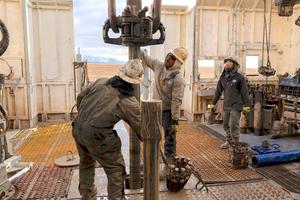Along a stretch of highway just outside the Bavarian market town of Holzkirchen lies an unremarkable cluster of two-story, wooden buildings, fenced off from a surrounding forest. As commuters pass on their way to Munich from the affluent towns tucked into the Alps foothills, they might not notice Geothermie Holzkirchen, a heating and power plant that occupies about two football fields and emits neither noise nor air pollution.
The Holzkirchen geothermal power plant is one of a half-dozen such unobtrusive facilities south of Munich, a city of 1.5 million that intends to be the world’s first municipality of its size to heat most of its homes and businesses with geothermal energy, thus make its entire heating system carbon-neutral by 2040. Some of the additional plants will be on Munich’s outskirts, where district heating grids will be linked with the Bavarian capital, while others will be in the heart of Munich’s busy downtown.
“Munich realized that it can’t hit climate targets unless it addresses heating, and Bavaria has deep thermal water flows between the Alps and the Danube that are ideal for geoenergy,” explains Michael Solic of Stadtwerke München, the city’s municipal utility. While the Alps’ geological conditions favor geothermal energy, the growing exploitation of this renewable resource in Bavaria shows that many other regions worldwide could tap into geothermal sources to heat homes and buildings and to generate electricity, Solic says.
The Bavarians have proven themselves particularly astute at tapping into federal price support schemes for renewables.
Munich and Bavaria are hardly newcomers to the business of clean energy. They’re embracing geothermal for the same reason Bavaria is a European stronghold of solar power and agriculture-based bioenergy: In addition to being in the vanguard of the renewables revolution, what Germany calls its Energiewende, the southern Germans see lucrative markets there, too. The Munich-based regional government has involved businesses, NGOs, scientists, and local officials in green energy ventures, with marked success. Indeed, Bavaria has profited like no other German state from the Energiewende, which has brought subsidies and tax breaks, created jobs, and provided a steady second income for farmers. The Bavarians have proven themselves particularly astute at tapping into federal price support schemes for renewables.
Until now, geothermal energy — basically hot water or steam drawn from the Earth — has been on the margins of the robust rollout of renewables in Europe, where solar and wind power dominate the landscape. In contrast to solar and wind, geothermal remains a pricey and capital-intensive investment. In addition, the danger of triggering earthquakes when deep hydraulic fracking is involved scares off some potential investors.
Geothermal accounts for just 0.3 percent of the European Union’s primary energy production; worldwide, the exploitation of geothermal energy is even lower. The modest European figures, though, don’t count non-EU heavyweights Iceland and Turkey, the latter a breakout prodigy that more than doubled its capacity between 2016 and 2018 to a record-breaking 1,347 megawatts — enough to power several million homes. Not only do parts of Turkey lie near dynamic tectonic activity, providing abundant geothermal resources, but Turkey’s government is fully behind the push. Its 2025 target is to have 7,000 megawatts of geothermal capacity as it strives to satisfy the energy demands of a burgeoning middle class. Turkey’s current geothermal capacity is more than the entire 28 countries of the EU combined. Nearly 90 percent of Iceland’s heating comes from its ubiquitous volcanic reservoirs.
Other places in Europe have been tapping into geothermal power, some of them for decades. Paris, which also sits atop an auspicious geological formation, currently provides about 900,000 people with geothermal heat. The French capital also benefits from generous state subsidizes for geothermal energy and is planning to expand beyond the roughly 50 geothermal plants now in operation.
A geothermal drill in northeastern Paris, which provides heat to nearby homes and businesses. Sipa via AP Images
Geothermal heating is particularly well-suited for many European cities because they have centralized district heating systems, in contrast to U.S. cities, where homes and buildings generally have their own heating units. Yet despite progress in Europe and Turkey, the International Energy Agency (IEA) says that geothermally generated heat and electricity production globally is far behind what is needed to play a significant role in reducing greenhouse gas emissions.
Europe’s energy planners say that geothermal energy’s key use will be in heating and cooling, which together account for almost half of the EU’s energy demand.
“At least in the short term, there’s no alternative to geothermal to replace fossil fuels and nuclear power in decarbonizing the heating sector,” says Thomas Reinsch, a geoenergy expert at the Helmholtz Center Potsdam, a research institute. Geothermal sources can also generate electricity by using steam to drive turbines.
The discrepancy between geothermal’s potential and its results has frustrated its enthusiasts. “It’s completely irrational that geothermal is so underused,” says Ingo Sass, a professor of geothermal science at The Technical University in Darmstadt. “The technology’s there, and economies of scale will follow quickly. Unlike wind and solar, geothermal provides both heat and cooling, as well as baseload power generation, and does so 24/7.” Sass notes that geothermal storage — the storing of hot and cold water in underground aquifers — is also coming into play.
Most experts agree that awareness and social acceptance of geothermal energy lags behind its technology’s maturity. “Engineers tend to be wary of underground geology because everywhere it has a unique composition,” says Sass, citing faults and fractures, groundwater issues, reservoir depths, and sediment composition. “That means lots of testing and then adjusting every project and the technologies to specific, on-site conditions. It can be tricky and time-consuming, but it’s doable.”
It took eight years to generate a single kilowatt-hour of geothermal energy in Holzkirchen.
The idea for the Holzkirchen plant was born in 2002 as a community energy project financed by the town of 17,000. Although traditionally a politically conservative district, Holzkirchen had long been an enthusiastic participant in Energiewende and was eager to explore a new frontier after years of rolling out solar power and bioenergy. “We wanted to be better, to go further,” explains Robert Wiechmann, a member of the Holzkirchen city administration. From the beginning, the undertaking was also a calculated business endeavor: the small but well-heeled municipality was on the lookout for a lucrative investment. The $45 million price tag was far beyond its means, but a government price support scheme for geothermal power would, once the turbines kicked in, guarantee Holzkirchen Geothermal an above-market price for its electricity for 20 years. That was the pledge the banks needed to sign off on the loans.
A professional forest ranger and Green Party member, Weichmann backed the high-risk, capital-intensive project from day one. It took eight years to generate a single kilowatt-hour of energy. The municipality knew it was taking a risk since it had to prove that the geological conditions were right before it could design a business model and apply for bank loans. The original exploration, which meant drilling a single test vent, cost the municipality $11 million, and if it didn’t yield positive results, a second shot would cost the same — money the municipality didn’t have. But, says Weichmann, “The geology was right, the water temperature was right, and size of the reservoir was right.”
Recently, I strolled through the plant’s spare, neatly kept grounds with Weichmann, who noted that Holzkirchen’s well, the deepest in Europe, reaches 3.5 miles underground. Drilling costs can run 40 to 70 percent of the total cost of geoenergy plants; in Holzkirchen it was closer to 70 percent. The drill heads broke and got stuck, drillers hit a gas bubble that they had to circumvent, and inserting the deep well pumps, which are used to pump geothermal fluids to the surface, was held up repeatedly. “Geothermal: A Cash Cow or Sinkhole?” taunted the daily Münchner Merkur newspaper in 2016, questioning whether Holzkirchen would ever recover its investment.
Inside the Holzkirchen geothermal power plant, located south of Munich. Credit: Gemeindewerke Holzkirchen
Yet despite the obstacles, today Geothermie Holzkirchen is generating heat and electricity, bringing in revenues of more than $9 million a year; at the current rate, the town expects to pay off the remainder of the loan in several years. The project’s federal price guarantees are the same that have enabled Germany to expand solar power and onshore wind energy from the Baltic Sea to the Black Forest. Many German citizens have supported Energiewende, though others have complained that government subsidies have significantly increased utility bills.
The technology for geothermal is not overly complicated. The drilling relies upon the kind of rig that petroleum companies have used for decades to drill for oil. The Holzkirchen plant’s heart is the well, a single vent with built-in underground pumps that force the 311-Fahrenheit water to the surface. Next to it, a heating center transforms the hot thermal water into a somewhat cooler water, since 311 degrees is too hot for the system that flows into the district heating grid, providing not only heat but hot water. The plant’s jewel is the turbine house — worth more than a million dollars itself — where steam is turned into electricity that runs into the power grid, for which the regional grid operator compensates the municipality.
For centuries, people have exploited shallower geothermal sources for bathing, and today, with the aid of heat pumps, lower-temperature aquifers can also provide hot water and heat for buildings, greenhouses, and certain industrial processes. Electrical heat pumps raise the temperature of air or water sources by compressing refrigerant gases, and can also work in reverse for purposes of cooling. A niche technology a decade ago, they’re so widespread today in Europe that shallow geothermal plants outnumber and out-produce deep geothermal installations.
“Heat pumps turn one kilowatt of electricity into three or four kilowatt-hours of heat,” explains Jörg Mühlenhoff of Climate Action Network (CAN) Europe.
A technique called enhanced geothermal drilling, similar to fracking, has set off earthquakes in some locales.
Some experts warn against overhyping geothermal energy, which carries risks beyond the financial hazards. In Berlin, city authorities have banned geothermal installations, citing extremely permeable subsoil and rock that could lead to geothermal wells contaminating underground aquifers. In addition, a technique called enhanced geothermal drilling — which increases subterranean water flows by injecting water into underground formations, similar to techniques used in fracking for oil and gas — has set off earthquakes in some locales. Most have been mild, although enhancement drilling in a geothermal well in South Korea in 2017 caused a magnitude 5.4 earthquake that collapsed buildings and injured more than 100 people.
Industry experts say that comprehensive monitoring — done with seismometers that pick up the sounds that fractures make when they grow — can avert serious seismic activity. And they say that much of Europe could exploit geothermal resources without using enhancement techniques.
Geothermal wells can extract energy for as long as 50 years before the underground infrastructure collapses. Holzkirchen is now reaping those benefits; even the Münchener Merkur newspaper, the project’s one-time critic, is now overflowing with praise.





